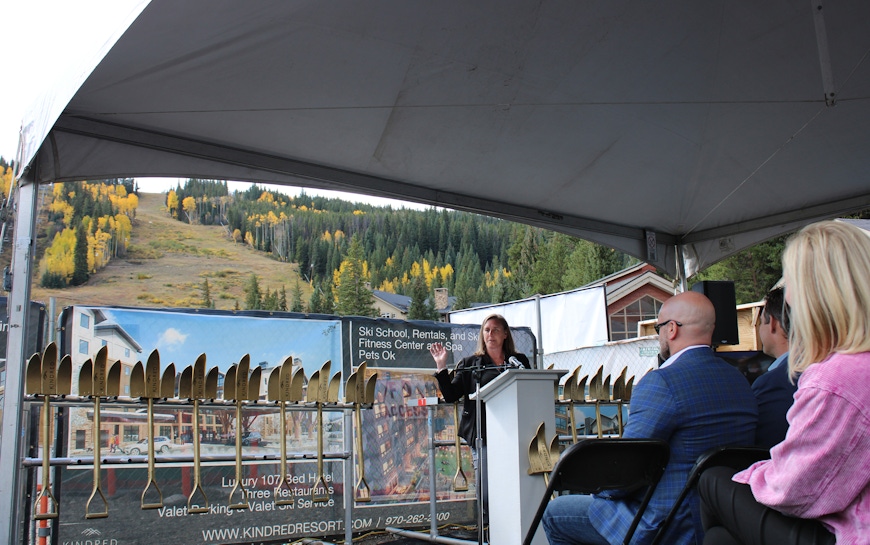Placemaking for the whole community, reducing environmental impact and creating vibrancy with a new mix of uses are all increasingly influencing development in Colorado’s mountain resort communities, according to OZ Architecture’s Rebecca Stone, Principal, AIA, LEED AP BD+C, who spoke on the topic at last week’s Bisnow’s 2023 Denver Construction and Development Conference.
Enhancing Place, Preserving Character
Following a red-hot real estate streak in Colorado’s mountain communities driven by an urban (and coastal) exodus during the height of the COVID pandemic, and the subsequent normalization of work-from-anywhere policies, mountain resort communities are seeing a resurgence of new product for the first time in years. Largely designed decades ago, these communities are now examining ways to evolve to keep up with demand and shifting visitor expectations by offering a new mix of uses. As resort communities expand, designing to maintain the local character and sense of place is a key tenet for the OZ Resorts & Hospitality Practice Area. Both enhancements of existing buildings and new development are inevitable as the needs evolve. Understanding the uniqueness of each town, the people who have been instrumental to its history and designing in harmony with existing architecture are the secret sauce that makes mountain communities special places to visit.
Making this evolution more challenging, nearly all resort communities are facing a critical housing shortage for the workforce that keeps them running. They also are bursting at the seams from an infrastructure perspective and have municipal needs such as fire stations, medical buildings and schools. Many mountain communities are now finding themselves at a crucial juncture. To thrive, communities must employ a more holistic approach that supports the entire resort ecosystem, year-round.
Enriching Amenities, Supporting New Uses
As part of the effort to create unique destinations, resorts are reimagining and updating their offerings with an emphasis on placemaking and preserving local character while adding vibrancy and hot beds though a mix of uses. In particular, for-sale residential, boutique-style hotels, elevated F&B offerings and place-based amenities are all essential considerations for the modern mixed-use ski base area. These developments are geared towards guests and locals and designed to be inviting hubs for social interaction. This shift to inclusion-design from exclusive-design is enlivening base areas as developers and operators seek ways to provide opportunities to gather, from morning coffee through late night entertainment. Flexible spaces with shifting uses, and consideration of all generations and varied activity levels, are critical to supporting desired guest experiences.


In Keystone’s River Run Village, for example, OZ Architecture is working with Kindred LLC, Liv Sotheby’s and operator RockResorts on Kindred Resort, the first new development in Keystone in nearly two decades. This state-of-the art, amenity-rich, mixed-used development will become the ‘living room to Keystone,’ featuring a luxury 107-key hotel as well as 95 for-sale condominiums, three restaurants, a mountain club, a day spa, a pool amenity, public courtyards and gathering space, the new Keystone Ski & Ride School, and ski retail/skier service space.
Increasing Resiliency, Reducing Environmental Impact
Given that the effects of climate change have the tremendous potential impact on the economic wellbeing mountain resort communities, many resort operators have made major commitments to combatting global warming and environmental degradation
Not only are these operators leading the way among outdoor recreation industries in taking immediate and measurable action to combat the effects of climate change, they are eager to share their journey and approach with visitors and have engaged with firms like OZ Architecture to envision creative design solutions to help them not only meet ambitious climate goals, but to share their values with their guests.
Rebecca shared at the Bisnow event that the firm is seeing a growing embrace of sustainable certification programs ranging from the more traditional LEED to newer programs like WELL, Green Globes and the Living Building Challenge. Some of the more aggressive sustainable design features are becoming the norm in mountain communities, from the incorporation of geothermal, solar and wind power to make entire developments self-sustaining to the use of locally sourced, hyper-resilient materials to ensure buildings are protected against the elements for generations.
From climate change to evolving guest expectations, mountain resort communities are increasingly recognizing the imperative to adapt and create a sustainable, prosperous future. OZ Architecture is proud to be supporting these efforts at resorts across the country. Head over to our Resorts & Hospitality Practice Area page to see more of our latest work.